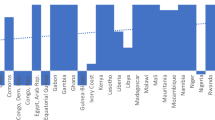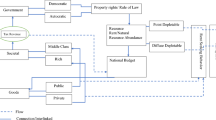Abstract
The resource curse has been mainly studied using cross-country samples. In this paper we analyze a cross-province sample from one country: China. We focus on the interplay between resource abundance, institutional quality, and economic growth, using two different measures of resource abundance (a stock: resource reserves; and a flow: resource revenues), and employing various econometric approaches including varying coefficient models. We find that resource abundance has a positive effect on economic growth at the provincial level in China between 1990 and 2008, an effect that depends nonlinearly on institutional quality (1995 confidence in courts). The ‘West China Development Drive’ policy, initiated in 2000, caused substantial changes, which we investigate through a comparative panel-data analysis.





Similar content being viewed by others
References
Acemoglu D, Johnson S, Robinson JA (2001) The colonial origins of comparative development: an empirical investigation. Am Econ Rev 91:1369–1401
Auty RM (2001) The political economy of resource-driven growth. Eur Econ Rev 45:839–846
Beck T, Levine R (2005) Legal institutions and financial development. In: Ménard C, Shirley MM (eds) Handbook of new institutional economics. Springer, Dordrecht, pp 251–278
Brunnschweiler CN, Bulte EH (2008) The resource curse revisited and revised: a tale of paradoxes and red herrings. J Environ Econ Manag 55:248–264
Bulte EH, Damania R, Deacon RT (2005) Resource intensity, institutions, and development. World Dev 33(7):1029–1044
Cai Z, Fan J, Yao Q (2000) Functional-coefficient regression models for nonlinear time series. J Am Stat Assoc 95(451):941–956
Claessens S, Laeven L (2003) Financial development, property rights, and growth. J Finance 58(6):2401–2436
Collier P, Goderis B (2008) Commodity prices, growth, and the natural resource curse: reconciling a conundrum. MPRA Paper 17315, University Library of Munich, Germany
Fan J, Gijbels I (1996) Local polynomial modelling and its applications. Chapman and Hall, London
Fan R, Fang Y, Park SY (2012) Resource abundance and economic growth in China. China Econ Rev 23(3): 704–719
Habakkuk HJ (1962) American and British technology in the nineteenth century. Cambridge University Press, Cambridge
Hoover DR, Rice JA, Wu CO, Yang L (1998) Nonparametric smoothing estimates of time-varying coefficient models with longitudinal data. Biometrika 85(4):809–822
Isham J, Woolcock M, Pritchett L, Busby G (2005) The varieties of resource experience: natural resource export structures and the political economy of economic growth. World Bank Econ Rev 19(2):141–174
Knack S, Keefer P (1995) Institutions and economic performance: cross-country tests using alternative institutional measures. Econ Polit 7(3):207–227
Leite C, Weidmann J (1999) Does mother nature corrupt? Natural resources, corruption, and economic growth. IMF Working Paper 99/85, International Monetary Fund
Mehlum H, Moene K, Torvik R (2006) Institutions and the resource curse. Econ J 116(508):1–20
Ministry of Land and Resources (2000–2009) China land and resources statistical yearbook. Geological Publishing House, Beijing, 2000–2009 edition
National Bureau of Statistics (2003–2004) China statistical yearbook. China Statistics Press, Beijing, 2003–2004 edition
Norman C (2009) Rule of law and the resource curse: abundance versus intensity. Environ Resour Econ 43(2):183–207
Nunn N (2007) Relationship-specificity, incomplete contracts, and the pattern of trade. Q J Econ 122(2): 569–600
Olken BA (2009) Corruption perceptions vs. corruption reality. J Public Econ 93(7–8):950–964
Papyrakis E, Gerlagh R (2007) Resource abundance and economic growth in the United States. Eur Econ Rev 51(4):1011–1039
Ross ML (2001) Timber booms and institutional breakdown in Southeast Asia. Cambridge University Press, Cambridge
Sachs JD, Warner AM (1995) Natural resource abundance and economic growth. NBER Working Paper 5398, National Bureau of Economic Research
Shao S, Qi Z (2009) Energy exploitation and economic growth in Western China: an empirical analysis based on the resource curse hypothesis. Front Econ China 4(1):125–152
Van der Ploeg F, Poelhekke S (2010) The pungent smell of “red herrings”: subsoil assets, rents, volatility and the resource curse. J Environ Econ Manag 60(1):44–55
Xu K, Wang J (2006) An empirical study of a linkage between natural resource abundance and economic development. Econ Res J 78–89 (in Chinese)
Zhang X, Xing L, Fan S, Luo X (2008) Resource abundance and regional development in China. Econ Transition 16(1):7–29
Author information
Authors and Affiliations
Corresponding author
Additional information
We are grateful to Thorsten Beck, Erwin Bulte, Pavel Čížek, Reyer Gerlagh, Harry Huizinga, Charles van Marrewijk, Daan van Soest, and seminar participants at Tilburg University for useful comments; to Ying Fang and Yang Zhao for stimulating us to investigate this topic and sharing institutional data; and to two referees for constructive comments.
Rights and permissions
About this article
Cite this article
Ji, K., Magnus, J.R. & Wang, W. Natural Resources, Institutional Quality, and Economic Growth in China. Environ Resource Econ 57, 323–343 (2014). https://doi.org/10.1007/s10640-013-9673-8
Accepted:
Published:
Issue Date:
DOI: https://doi.org/10.1007/s10640-013-9673-8
Keywords
- Natural resource curse
- Economic growth
- China
- Institutional quality
- Resource abundance
- Policy change
- Functional effect




